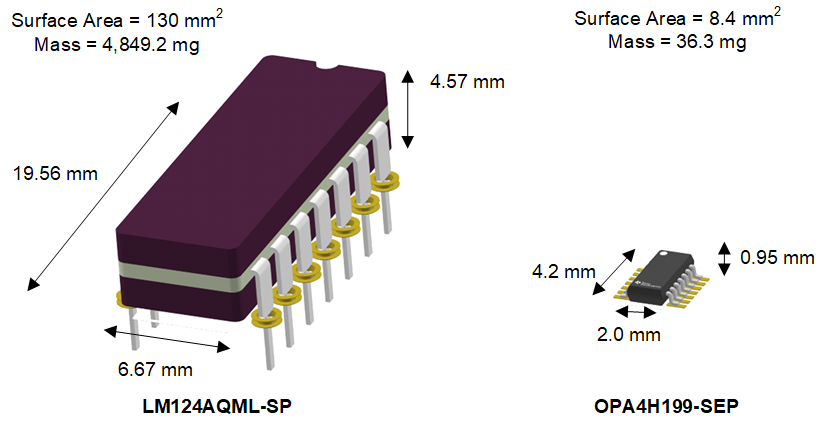SBOT046 November 2023 OPA4H199-SEP
Texas Instruments in Space is not an out of this world concept. Specifically, operational amplifiers are fundamental in a spacecraft’s electronic system, enabling designers to implement housekeeping functions like voltage sensing of bus voltages or maintaining signal integrity by buffering a signal before an analog-to-digital converter. Our OPA4H199-SEP is our next step in elevating your signal chain performance with significant improvements to performance while adhering to radiation requirements for different types of space missions all within our lightweight Space-Enhanced Plastic (SEP) packaging yielding savings in payload cost and minimizing the area occupied on your printed circuit board (PCB).
There are two types of missions: some lasting only a few months and others potentially lasting several years. These missions are known as Low-Earth Orbit (LEO) and Geostationary Orbit (GEO) missions, respectively. LEO missions are classified as missions within 2,000 km of Earth and last in orbit for two months up to two years. Geostationary missions can be as far as 36,000 km from Earth and last up to 15 years in orbit as shown in Figure 1. These two mission types have different radiation levels that a device must have resistance towards to avoid any damage from the radioactive environment where they are also exposed to solar flares. Table 1 summarizes the Total Ionizing Dose (TID) rating and Single Event Latch-up (SEL) rating a device must have per mission type.
 Figure 1 Distances of Low-Earth and Geostationary Orbit Missions
Figure 1 Distances of Low-Earth and Geostationary Orbit Missions| Mission Type | Total Ionization Dose Rating | Single Event Latch-up Rating |
|---|---|---|
| Low-Earth Orbit | 30 krad (Si) | 43 MeV-cm2/mg |
| Geostationary Orbit | 100 krad (Si) | 75 MeV-cm2/mg |
In the past, standard packaging options for amplifiers have long been ceramic to meet the radiation requirements for both LEO and GEO missions. These hermetically sealed options provide benefits such as creating a barrier from gases and moisture, offering high thermal resistance, and exhibiting a low thermal expansion coefficient. These ceramic packaging options also had a TID rating of 100 kRad and an SEL rating of 75 MeV. This radiation resistance was necessary for GEO missions, however, devices being used for LEO missions only needed to meet a TID rating of 30 kRad and an SEL rating of 43 MeV.
A limitation of ceramic packaging has been the unnecessarily large board area they consume and the weight contributed by each device. Newer packaging options now offer smaller, lighter amplifiers, which reduce the overall launch weight of the craft and are tailored to meet the radiation requirements for LEO missions. With the OPA4H199MDYYTSEP, TI provides a 40-V amplifier, great for monitoring higher voltage levels, conveniently housed in our new SOT-23-THIN-14 plastic packaging. This smaller package immediately addresses the limitations of the ceramic package and intersects the radiation requirements for LEO missions.
A common ceramic packaging option for space-grade amplifiers is the CDIP-14 package. On average, the weight of a quad-channel amplifier in CDIP packaging is 4,849.2 mg. Replacing this ceramic packaging with our SOT-23-THN-14 (36.3 mg) would drop the contributed weight from the amplifier by over 99%. Since amplifiers are typically used in redundant circuits the total contribution of this weight savings exponentially grows, lowering the cost of launch for the system significantly, potentially saving over $100 per part in launch cost (1). The OPA4H199MDYYTSEP is also the world’s smallest quad-channel leaded amplifier, over 89% smaller than the standard CDIP-14 packaging.
 Figure 2 Ceramic vs. Plastic Packaging Comparison
Figure 2 Ceramic vs. Plastic Packaging ComparisonBuilt on modern amplifier technology, the OPA4H199-SEP allows us to enable the full common-mode range at the input, which is key for monitoring voltages at the power supply rails. When monitoring these voltages, if the amplifier is paired with an ADC with a high resolution, offset voltage becomes critical in ensuring that a precise level is transmitted through the signal chain. The OPA4H199-SEP has an offset voltage of 0.895 mV(2), making it the most accurate space-grade amplifier in the General-Purpose Amplifier portfolio. The amplifier’s output current is also has top-of-the-line performance at 75 mA, useful for driving sensors at the load, making it the highest output current operational amplifier in TI’s space-grade general-purpose amplifier portfolio and the amplifier industry.
Texas Instruments continuously finds ways to help customers reach their design goals and improve the overall performance of their system while offering a wide-range of innovative device selections.
| LM124AQML-SP | OPA4H199-SEP | |
|---|---|---|
| Total Ionization Dose Rate (kRad) | 100 | 30 |
| Single-Event Latchup (MeV-cm2/mg) | 75 | 43 |
| Total Weight (mg) | 4,849.2 | 36.3 |
| Web price(3) | $270.53 | $200 |
Additional Information
For additional assistance, ask questions to TI engineers on the TI E2E™ Amplifiers Support Forum.